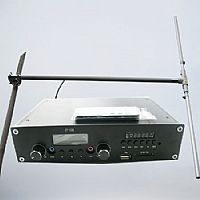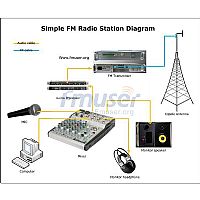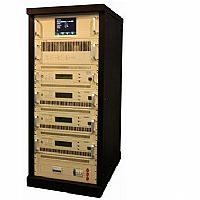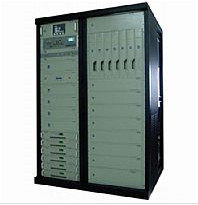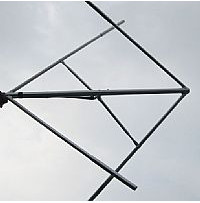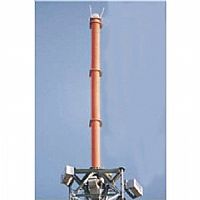After several years of development, radio transmitters have gradually transitioned from simple IF transmission architecture to quadrature IF transmitters and zero IF transmitters. However, these architectures still have limitations. The latest RF direct conversion transmitter can overcome the limitations of traditional transmitters. This article compares the characteristics of different transmission architectures in wireless communications. The RF direct conversion transmitter uses a high-performance digital-to-analog converter (DAC), which has obvious advantages over traditional technologies. The RF direct conversion transmitter also has its own challenges, but it paves the way for the realization of a true software radio transmission architecture.
RF DAC, such as 14-bit 2.3Gsps MAX5879, is the key circuit of RF direct conversion architecture. This DAC can provide excellent spurious and noise performance within a 1GHz bandwidth. The device adopts innovative design in the second and third Nyquist bands, supports signal transmission, and can synthesize radio frequency signals with an output frequency of up to 3GHz. The measurement results verify the performance of the DAC.
Traditional RF transmitter architecture
Over the past few decades, traditional transmitter architecture has been used to achieve superheterodyne design, using local oscillator (LO) and mixer to generate intermediate frequency (IF). The mixer usually generates two image frequencies (called sidebands) near the LO, and obtains a useful signal by filtering out one of the sidebands. Modern wireless transmission systems, especially base station (BTS) transmitters, mostly perform I and Q quadrature modulation on baseband digital modulation signals.
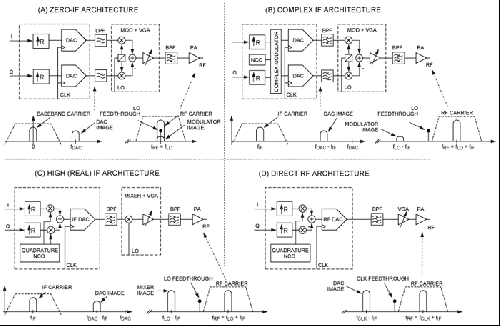
0Traditional RF transmitter architecture
Over the past few decades, traditional transmitter architecture has been used to achieve superheterodyne design, using local oscillator (LO) and mixer to generate intermediate frequency (IF). The mixer usually generates two image frequencies (called sidebands) near the LO, and obtains a useful signal by filtering out one of the sidebands. Modern wireless transmission systems, especially base station (BTS) transmitters, mostly perform I and Q quadrature modulation on baseband digital modulation signals.
Figure 1. Wireless transmitter architecture.
Quadrature IF transmitter
The complex baseband digital signal has two paths in the baseband: I and Q. The advantage of using two signal paths is that when using an analog quadrature modulator (MOD) to synthesize two complex IF signals, one of the IF sidebands is eliminated. However, due to the asymmetry of the I and Q channels, the image frequency of the modulator will not be perfectly offset. This quadrature IF architecture is shown in Figure 1(B). In the figure, a digital quadrature modulator and LO numerically controlled oscillator (NCO) are used to interpolate the I and Q baseband signals (coefficient R) and modulate them to positive Hand over IF carrier. Then, the dual DAC converts the digital I and Q IF carriers into analog signals and sends them to the modulator. In order to further increase the suppression of useless sidebands, the system also uses a bandpass filter (BPF).
Zero-IF transmitter
In the zero intermediate frequency (ZIF) transmitter shown in Figure 1(A), the baseband digital quadrature signal is interpolated to meet the filtering requirements; then it is sent to the DAC. The quadrature analog output of the DAC is also sent to the analog quadrature modulator at the baseband. Because the entire modulated signal is converted to an RF carrier at the LO frequency, the ZIF architecture really highlights the "charm" of quadrature mixing. However, considering that the I and Q paths are not ideal paths, such as LO leakage and asymmetry, inverted signal images (located within the range of the transmitted signal) will be generated, resulting in signal errors. In a multi-carrier transmitter, the image signal may be close to the carrier, causing in-band spurious radiation. Wireless transmitters often use complex digital predistortion to compensate for such defects.
In the RF direct conversion transmitter shown in Figure 1 (D), a quadrature demodulator is used in the digital domain, and the LO is replaced by an NCO, so that almost perfect symmetry is obtained in the I and Q channels, and there is basically no LO leakage. Therefore, the output of the digital modulator is a digital RF carrier, which is sent to the ultra-high-speed DAC. Since the DAC output is a discrete time signal, an aliased image frequency equal to the DAC clock frequency (CLK) is generated. The BPF filters the DAC output, selects the RF carrier, and then sends it to the variable gain amplifier (VGA).
High-IF transmitter
RF direct conversion transmitters can also use this method to generate higher intermediate frequency digital carriers, as shown in Figure 1(C). Here, the DAC converts the digital intermediate frequency into an analog intermediate frequency carrier. After the DAC, use the frequency selection characteristic of the band-pass filter to filter out the intermediate frequency image frequency. Then the required intermediate frequency signal is sent to the mixer to generate two sidebands where the IF signal is mixed with the LO, and filtered by another bandpass filter to obtain the required RF sideband.
Obviously, the RF direct conversion architecture requires minimal active components. Because FPGA or ASIC with digital quadrature modulator and NCO are used to replace analog quadrature modulator and LO, the RF direct frequency conversion architecture avoids the imbalance error of I and Q channels and LO leakage. In addition, because the sampling rate of the DAC is very high, it is easier to synthesize broadband signals, while ensuring that the filtering requirements are met.
The high-performance DAC is a key component for the RF direct conversion architecture to replace the traditional wireless transmitter. The DAC needs to generate a radio frequency carrier of up to 2GHz or higher, and the dynamic performance must reach the baseband or intermediate frequency performance provided by other architectures. MAX5879 is such a high-performance DAC.
Using MAX5879 DAC to Realize RF Direct Conversion Transmitter
The MAX5879 is a 14-bit, 2.3Gsps RF DAC with an output bandwidth greater than 2GHz, ultra-low noise and low spurious performance, and is designed for RF direct conversion transmitters. Its frequency response (Figure 2) can be set by changing its impulse response, and the non-return-to-zero (NRZ) mode is used for the first Nyquist band output. The RF mode focuses on the output power of the second and third Nyquist bands. The return-to-zero (RZ) mode provides flat response in multiple Nyquist bands, but lower output power. The unique feature of MAX5879 is the RFZ mode. The RFZ mode is a "zero fill" radio frequency mode, so the DAC input sampling rate is half of other modes. This mode is very useful for synthesizing signals with lower bandwidth and can output high-frequency signals in the high-order Nyquist band. So the MAX5879 DAC can be used to synthesize modulated carriers that exceed its sampling rate, only limited by the 2+GHz analog output bandwidth.
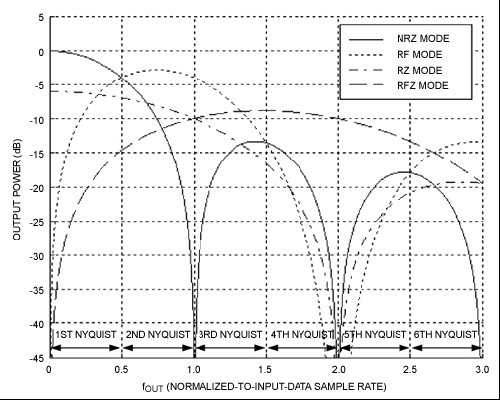
Figure 2. Selectable frequency response characteristics of the MAX5879 DAC. MAX5879 performance test shows that the intermodulation distortion of the 4-carrier GSM signal is greater than 74dB at 940MHz (Figure 3); at 2.1GHz, the adjacent channel leakage power ratio (ACLR) of the 4-carrier WCDMA signal is 67dB (Figure 4); at 2.6GHz , The ACLR of 2-carrier LTE is 65dB (Figure 5). The DAC with this performance can support the direct digital synthesis of various digital modulation signals in the multi-Nyquist frequency band, and can be used as a common hardware for multi-standard, multi-band wireless base station transmitters.
Figure 3. MAX5879 4-carrier GSM performance test, 940MHz and 2.3Gsps (first Nyquist band).
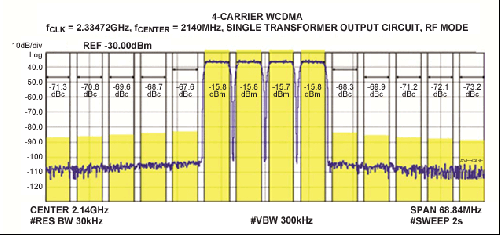
Figure 4. MAX5879 4-carrier WCDMA performance test, 2140MHz and 2.3Gsps (second Nyquist band).
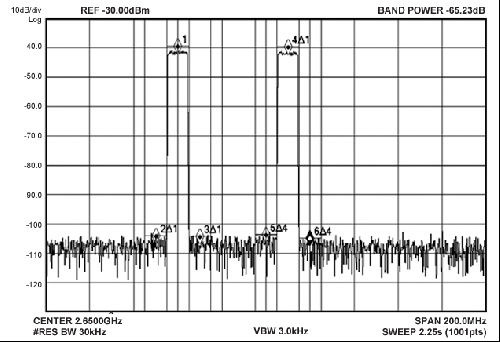
Figure 5. MAX5879 2-carrier LTE performance test, 2650MHz and 2.3Gsps (third Nyquist band).
RF direct conversion transmitter application
The MAX5879 DAC can also transmit multiple carriers in the Nyquist band simultaneously. This function is currently used in the downlink transmission link of cable television to send multiple QAM modulated signals in the 50MHz to 1000MHz frequency band. For this application, the carrier density supported by the RF direct conversion transmitter is 20-30 times that of other transmission architectures. In addition, because a single broadband RF direct conversion transmitter replaces multiple wireless transmitters, the power consumption and area of the cable TV front end are greatly reduced.
RF direct conversion transmitters based on MAX5879 can be used for broadband and high-frequency output applications. For example, with the increasing popularity of smart phones and tablet computers, wireless base stations will require a wider frequency band. There is no doubt that the current transmitters that support such devices will gradually be replaced by RF direct conversion transmitters based on high-performance RF DACs (such as MAX5879).
to sum up
The RF DAC-based transmitter has a transmission bandwidth far beyond the traditional architecture without loss of dynamic performance. It can be implemented using FPGA or ASIC, eliminating the need for analog quadrature modulators and LO synthesizers, thereby improving the reliability of wireless transmitters Sex. This scheme also greatly reduces the number of components, and in most cases also reduces system power consumption.
Our other product:





